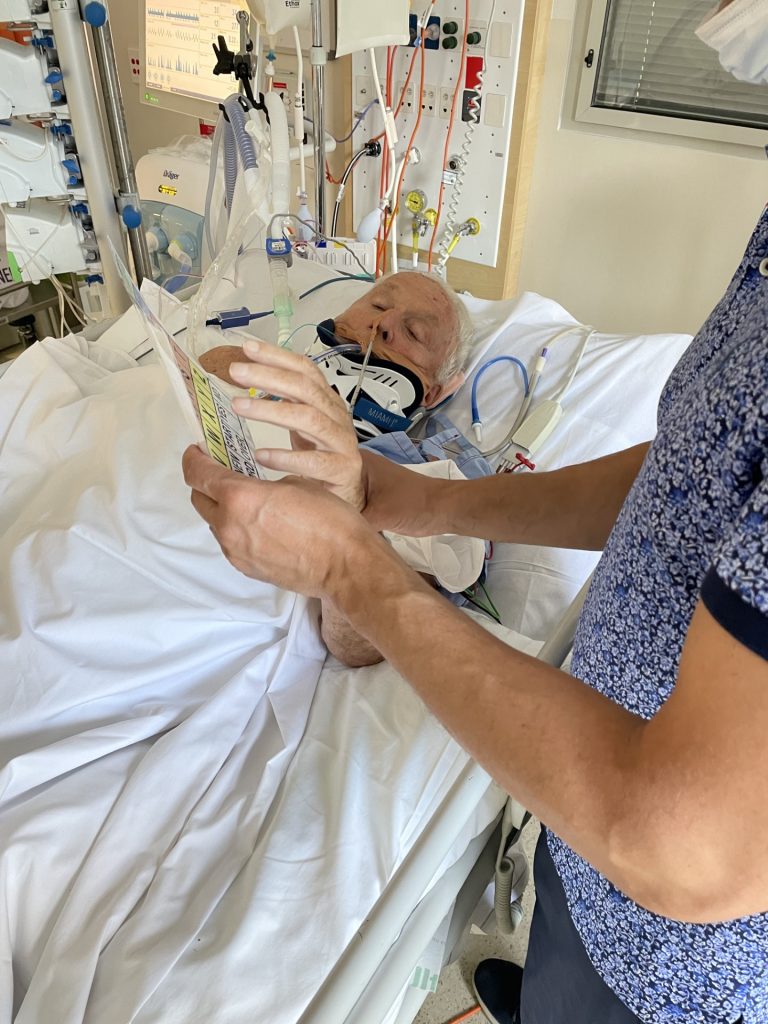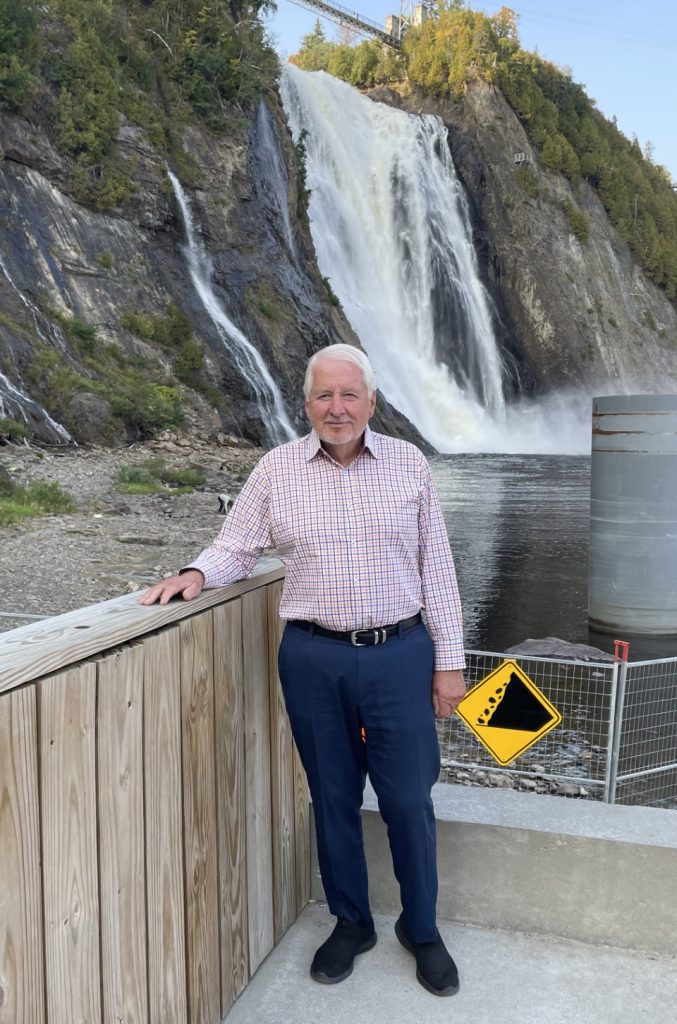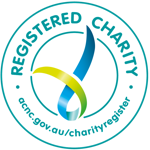
Every day in Australia, another person suffers a spinal cord injury.
While Ian grew up on Sydney’s North Shore, he and his wife Felicity now reside in Vancouver Canada, but they regularly return to Australia to visit family. Ian had a totally unexpected near-death experience when he recently visited for his sister’s celebration of life.
It was a beautiful summer’s day at Palm Beach, so Ian, 76, decided to go for a bodysurf with son, Trevor, while Felicity relaxed in his old club house reading the Sunday newspapers.
Having surfed all his life, Ian is confident in the water and familiar with the breaks at Palm Beach, however he awkwardly caught a wave and was slammed headfirst onto the seafloor.

Ian at RNSH a week post accident
“I remember the intensity of the injury and trying to lift my head but couldn’t”, Ian recalls. “I was underwater, and I realised I was possibly drowning and that put the fear of God into me.”
Alerted to their distress, two doctors who had just finished a swim coupled with a Surf Life Saving patrol member, assisted a semiconscious Ian to the beach. Ian then collapsed and went into cardiac arrest. An off duty intensive care nurse passing by, observed that he had stopped breathing and displayed no signs of life and commenced CPR.
Around 25,000 Australians suffer a cardiac arrest outside of hospital every year. Only 10% of people will survive an out of hospital cardiac arrest.
It was a situation of being at the right place at the right time as the incident occurring directly in front of the patrol tent which had emergency equipment, including a defibrillator and oxygen. Lifeguards also performed CPR on Ian, and the defibrillator was used to restart his heart. They placed Ian on a spine board as there was a concern he had suffered a spinal injury as a result of his head striking the sandbank.
Meanwhile Ian’s granddaughter raced to the club house to alert Felicity saying, “Granny come quickly, Pappa is dying!“
The urgency to have Ian cared for immediately meant he had to be transferred by CareFlight to Royal North Shore Hospital (RNSH) which provides specialist services for people with spinal cord injuries. Concerned he had suffered potentially serious injuries that may compromise his breathing, the CareFlight trauma doctor placed Ian into an induced coma for transport to RNSH.
The Director of the Emergency Department, Dr Tom Harwood says, “Royal North Shore Hospital is the sole designated referral centre for people across NSW with acute traumatic spinal cord injuries.”
“A cervical spine injury like Ian’s is potentially devastating. The Emergency Department at Royal North Shore Hospital is proud to be part of an expert medical and nursing workforce that is ready at all times to deliver world class care to optimise patient outcomes from these most serious of injuries “
It was a nervous wait for Ian’s family as they didn’t know what life changing injuries he had sustained in the accident. The spinal cord is an extension of the central nervous system, and an injury at the cervical level usually results in the reduction or loss of motor and/or sensory function in the arms as well as in the trunk, legs and pelvic organs.

Ian in rehab at RNSH
In time, and after being cared for by some of the best trauma doctors in Sydney, Ian was operated on for fractures to his C1 and C2 vertebra which form the top of the cervical spine at the base of the skull. Injuries to the spinal cord that lies inside the spinal column are often fatal at this level as the brain is starved of a vital supply of blood.
Due to the areas of the vertebra Ian injured he still wasn’t out of the clear and had to lie still in bed for one-week post-surgery as he was still in the “danger zone”.
Ian says that his healthcare team were so helpful and kind and even though they would be seeing many other patients, they were genuinely interested in his recovery with enormous attention given to him. One of his most striking memories was the friendliness and professionalism of the hospital staff from the extraordinary doctors to the resourceful and sunny disposition of the nurses and the diligent kitchen staff. Ian felt they all had the strongest work ethic and saw it as their mission to get him better as quickly as possible so he could go home.
“The nursing staff were just unbelievably dedicated and caring and went beyond the call of duty and I just can’t thank them enough. In the first week I was only able to lie down and told not to move,” said Ian. “During this time, the nurses would comfort me, motivate me and reassure me with positive thoughts and a caring smile.”
Ian contracted pneumonia, which was a setback in his recovery, but essentially the operation was a success. Ian spent three weeks in Intensive Care Unit (ICU) and a total of two months at RNSH in the spinal cord injury unit where he had regular physiotherapy to aid his rehabilitation. Ian gives enormous credit to the therapists who helped push him to conquer feats which initially seem utterly impossible in returning his mobility.

Ian in Quebec City 8 months post accident
He says his rate of recovery was testament to the healthcare service that he was provided, and he was able to return to Canada ten days after leaving hospital. Initially he had a fear of the water but after six months he was swimming in Vancouver harbour. Ian is aware that full recovery will take up to 24 months after the accident, but each day he sees some improvement. While his “jelly feet” mean that he is a little unstable and unable to play golf and tennis now, he is not bitter and feels very blessed that he is still able to enjoy his life and his family.
Ian states: “I’ve benefitted from the shade of trees planted by others, now it’s time for me to plant some trees.”
Ian had experienced the incident with so many resources and skills immediately available to help him which undoubtedly saved his life. He is forever grateful for the phenomenal care, he and other members of his family received over the years at RNSH, that he has become a generous regular donor to the spinal cord injury unit.
Ian recited a quote by Winston Churchill – We make a living by what we get but make a life by what we give – and believes you shouldn’t wait until you die to give. “It should give you nothing but satisfaction to donate while you can, and you will see the benefits from your investment into healthcare which will lay the seed that can bear fruit later,” Ian stated.
If you would like to support patients with life-changing injuries at the spinal cord injury unit to regain their independence, please make a donation here.

